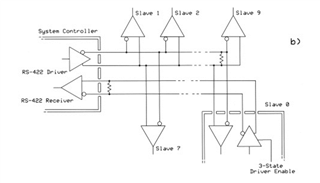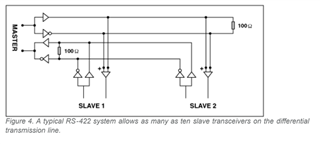Other Parts Discussed in Thread: AM26LV32, AM26LV31
Hello,
I am trying to understand the difference between RS485 and RS422. I have read as many TI app notes as I could find along with a few from other sources. I have a strong understanding of the electrical minimums and maximums. As I understand them, both only specify hardware characteristics and nothing in software (different than CAN which is hardware and software).
I would like some clarification on the transceivers used for each, I understand that most RS-485 transceivers are compatible with RS-422, but not the other way around. RS-485’s driver must have a tri-state transceiver so that when more than one transmitter is on a bus the active one goes high/low and the inactive ones are High-Z. Is this the same case for conventional RS-422 transceivers? I would like to reference a Renesas app note that shows the two conventional transceiver types:


AN1989: RS-422 vs RS-485: Similarities and Key Differences (renesas.com)
For the THVD1424 does it align with the RS-485 transceiver with the shottkey diode in series? Possibly swapping out the BJTs with MOSFETs.
My confusion arises when comparing RS-422 and RS-485 4-wire schematics. RS-422 is meant to be multidrop(1 MASTER transmitter and multiple SLAVE receivers), while RS-485 is meant to be multipoint(multiple transmitters and multiple receivers). For RS-422 if a SLAVE wanted to transmit back to the MASTER, would RS-422 mandate that only 1 SLAVE transmitter be connected to the MASTER’s receiver to comply with only 1 transmitter allowed on a pair of wires? Below is a depiction of what I am trying to ask.
Above is my understanding of RS-422, although the 3 state/tri-state driver is not needed since it is the only transmitter on that pair of wires and aligns with the RS 485 transceiver in the Renesas app note.

Maxim depiction taken from Guide to Selecting and Using RS-232, RS-422, and RS-485 Serial Data Standards | Analog Devices. Here 2 SLAVE transmitters are on the same bus, is this also RS-422?
It is reiterated here as well:

From: Basics of RS-422 and RS-485 Communications - Sealevel
Any help clarifying this would be much appreciated. The only way I can reason through this is that a legacy RS-422 design got a new RS-485 transceiver put in it and enabled the multiple transceiver SLAVE to MASTER communication route and kept the RS-422 branding since there is technically a master.
Thanks for the help


